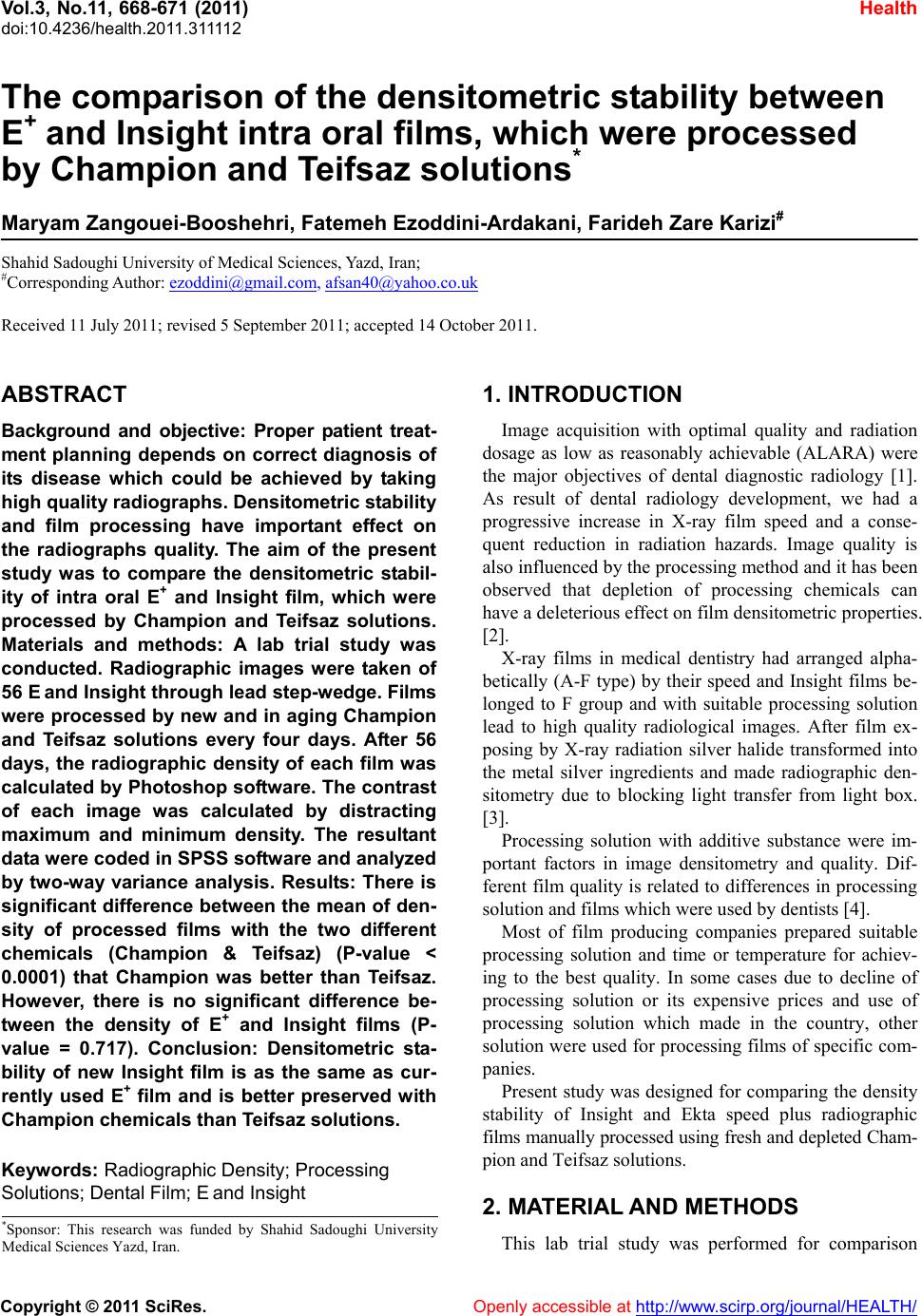
Vol.3, No.11, 668-671 (2011)
doi:10.4236/health.2011.311112
C
opyright © 2011 SciRes. Openly accessible at http://www.scirp.org/journal/HEALTH/
Health
The comparison of the densitometric stability between
E+ and Insight intra oral films, which were processed
by Champion and Teifsaz solutions*
Maryam Zangouei-Booshehri, Fatemeh Ezoddini-Ardakani, Farideh Zare Karizi#
Shahid Sadoughi University of Medical Sciences, Yazd, Iran;
#Corresponding Aut hor: ezoddini@gmail.com, afsan40@yahoo.co.uk
Received 11 July 2011; revised 5 September 2011; accepted 14 October 2011.
ABSTRACT
Background and objective: Proper patient treat-
ment planning depends on correct diagnosis of
its disease which could be achieved by taking
high quality radiographs. Densitometric stability
and film processing have important effect on
the radiographs quality. The aim of the present
study was to compare the densitometric stabil-
ity of intra oral E+ and Insight film, which were
processed by Champion and Teifsaz solutions.
Materials and methods: A lab trial study was
conducted. Radiographic images were taken of
56 E and Insight through lead step-wedge. Films
were processed by new and in aging Champion
and Teifsaz solutions every four days. After 56
days, the radiographic density of each film was
calculated by Photoshop software. The contrast
of each image was calculated by distracting
maximum and minimum density. The resultant
data were coded in SPSS software and analyzed
by two-way variance analysis. Results: There is
significant difference between the mean of den-
sity of processed films with the two different
chemicals (Champion & Teifsaz) (P-value <
0.0001) that Champion was better than Teifsaz.
However, there is no significant difference be-
tween the density of E+ and Insight films (P-
value = 0.717). Conclusion: Densitometric sta-
bility of new Insight film is as the same as cur-
rently used E+ film and is better preserved with
Champion chemicals than Teifsaz solutions.
Keywords: Radiograp hic Density; Processing
Solutions; Dental Film; E and Insight
1. INTRODUCTION
Image acquisition with optimal quality and radiation
dosage as low as reasonably achievable (ALARA) were
the major objectives of dental diagnostic radiology [1].
As result of dental radiology development, we had a
progressive increase in X-ray film speed and a conse-
quent reduction in radiation hazards. Image quality is
also influenced by the processing method and it has been
observed that depletion of processing chemicals can
have a deleterious effect on film densitometric properties.
[2].
X-ray films in medical dentistry had arranged alpha-
betically (A-F type) by their speed and Insight films be-
longed to F group and with suitable processing solution
lead to high quality radiological images. After film ex-
posing by X-ray radiation silver halide transformed into
the metal silver ingredients and made radiographic den-
sitometry due to blocking light transfer from light box.
[3].
Processing solution with additive substance were im-
portant factors in image densitometry and quality. Dif-
ferent film quality is related to differences in processing
solution and films which were used by dentists [4].
Most of film producing companies prepared suitable
processing solution and time or temperature for achiev-
ing to the best quality. In some cases due to decline of
processing solution or its expensive prices and use of
processing solution which made in the country, other
solution were used for processing films of specific com-
panies.
Present study was designed for comparing the density
stability of Insight and Ekta speed plus radiographic
films manually processed using fresh and depleted Cham-
pion and Teifsaz solution s.
2. MATERIAL AND METHODS
*Sponsor: This research was funded by Shahid Sadoughi University
Medical Sciences Yazd, Iran. This lab trial study was performed for comparison